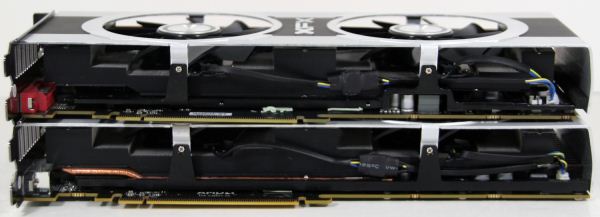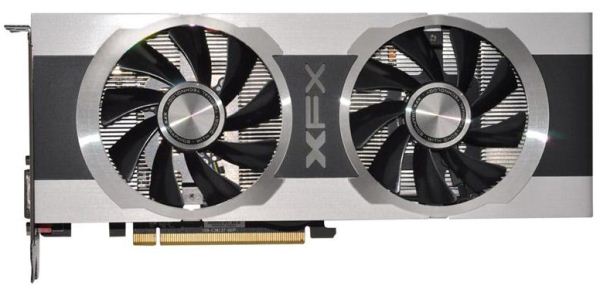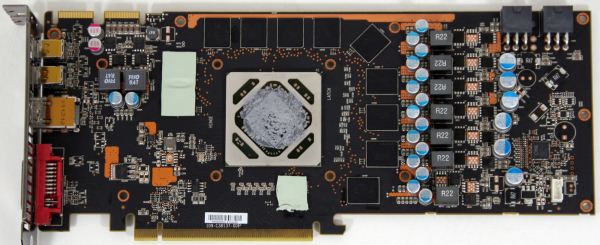AMD Radeon HD 7950 Review Feat. Sapphire & XFX: Sewing Up The High-End Market
by Ryan Smith on January 31, 2012 9:02 AM ESTMeet the XFX R7950 Black Edition Double Dissipation
Our second partner card of the day is XFX’s R7950 Black Edition Double Dissipation. Like the 7970 Black Edition Double Dissipation we reviewed earlier this month, the 7950 BEDD is a factory overclocked card (Black Edition) using XFX’s Double Dissipation cooler.
Starting with the overclock, XFX is shipping the 7950 BEDD with a core clock of 900MHz and a memory clock of 5.5GHz. This represents a 100MHz (12.5%) core clock overclock and 500MHz (10%) memory clock overclock, putting it just shy of the 925MHz core clock the 7970 ships at.
In terms of construction like all of the other 7950 cards launching today XFX is using AMD’s 7950 PCB. This means the PCB measures 10.25” long and features 2 6pin PCIe power sockets towards the rear of the card, while at the front the card uses the AMD standard port configuration of 1 DL-DVI, 1 HDMi, and 2 mini-DisplayPorts. The one notable deviation here from the Sapphire card is that XFX has not included a BIOS selection switch, so the card lacks any kind of ability to easily recover from a bad BIOS flash, and if unlocking proves viable it would not be a good candidate for the process.
Meanwhile cooling is provided by XFX’s Double Dissipation cooler. This is the same heatsink and fan assembly we saw with the 7970 BEDD, which makes this an open air cooler using a pair of fans to push air along an aluminum heatsink running almost the entire length of the card. Because it’s the same assembly, the shrouding for the card sticks out over the end of the PCB, negating the benefit of the shorter 7950 PCB and making the card 10.65” long just like the 7970 BEDD.

Top: 7950 BEDD. Bottom: 7970 BEDD
Do note that while it uses the same fan and heatsink assembly, Double Dissipation does not mean it uses the same vapor chamber assembly to transfer heat from the card. Where the 7970 BEDD used a fairly large vapor chamber, the 7950 BEDD uses a much smaller vapor chamber that only makes contact with roughly half of the heatsink, meaning that heat isn’t being transferred to the extremities of the heatsink nearly as well on the 7950 BEDD. Furthermore the aluminum plate covering the RAM and MOSFETs is poorly sized, leaving parts of the RAM chips (and their thermal pads) exposed. We’ll see how this plays out when we get to our testing, but the 7950 BEDD is clearly not as well built as the 7970 BEDD.
Rounding out the package is the same collection of extras that we saw in the 7970 BEDD. Inside you’ll find the usual driver CD and quick start guide, along with a metal XFX case badge, a mid-length CrossFire bridge, and a passive HDMI to SL-DVI adaptor. All of this is packed in one of XFX’s pleasantly small boxes, which doesn’t use much more space than the card itself.
The MSRP on the 7950 BEDD is $499, $50 over the MSRP for a regular 7950 and making it one of the more expensive 7950s launching today. XFX is offering a base 2 year warranty on the 7950 BEDD, which can be extended to a lifetime warranty by registering the card within 30 days of purchasing it.












259 Comments
View All Comments
chizow - Saturday, February 4, 2012 - link
I have explained this. Because the market expects there to be a shift in the price:performance metrics when a new generation or new architecture of GPUs launches. This is the driving factor of progress, more performance at the same prices.Tahiti offers none of this, so once again, AMD is either ignoring the fact Nvidia 28nm parts are imminent and may very well invalidate their entire product line a few months after launch. Or they think Nvidia's 28nm parts aren't any faster than their 40nm parts. Or they think their customers are stupid.
In all 3 cases, I can't see this ending well for them. Unless Nvidia prices their new parts to the moon like $750+, and then no one wins (or has any reason to upgrade for that matter). The only people who would have any incentive to upgrade will be the ones who need to have the absolute fastest, then they'll have to decide if $750/1500/2250/3000 is worth it for a minor bump in performance over what they had with $500 flagship parts.
chizow - Saturday, February 4, 2012 - link
Well, you'd be stupid not to verify and fact check what I've stated by referencing the financials before opening your mouth. Its all right there, links and everything.Given your other comments on the topic however, ignorantly commenting seems par for the course with you.
chizow - Saturday, February 4, 2012 - link
I'm well aware of that. I'm also well aware that top-end performance from 3 years ago doesn't command $1000 prices anymore, it fetches $300 max. That's what we call progress.Its also why AMD can only charge $200 for their top-end CPU, because what they have today still doesn't compete with what Intel has at $300 today and what they asked $1000 for 3-years ago.
But its OK, you've made it abundantly clear you see nothing wrong with charging the same price for the same performance as last-gen parts some 14 months later.
chizow - Saturday, February 4, 2012 - link
Is it nice for you? Because you're clearly out of your league in this discussion.chizow - Saturday, February 4, 2012 - link
CYA!Galidou - Sunday, February 5, 2012 - link
Oh yeah, if the pricing is so stupid, why is it out of stock everywhere after a week?Oh right, supply and demand is a market thing but the only thing you understand is history of pricing and ATI being a company that doesn't know what they do, maybe you should become marketting master, seems like you'Re right about everything in the damn world...
Galidou - Sunday, February 5, 2012 - link
They freaking knew what they were doing FFS.And from the beginning I knew nothing was SO wrong with it because if it was the case, they wouldn't of sold EVERYTHING in a damn week...
Prices will go down soon, they just knew the initial stock would sell like hotcakes and when it starts to slow down, price it accordingly.
Supply and demand...
chizow - Saturday, February 4, 2012 - link
And apparently this is the same mistake AMD has made by shoving in their head in the sand trying to ignore that ominous cloud called Kepler.Its fine, buy these cards today, regret the decision tomorrow, a month from now, two months from now.
I know the AMD fanboys probably hate me today for pointing this out and shoving it in their faces, but I can guarantee you anyone who buys one of these cards today won't be mad at me when Kepler cuts their price at the knees, they'll be pissed off at AMD.
chizow - Saturday, February 4, 2012 - link
This is the online equivalent of holding your hands over year ears and shouting "lalala I can't hear you lalala".Your arguments were pretty weak to begin with but now they've just devolved into childish nonsense.
chizow - Saturday, February 4, 2012 - link
Um, no you're wrong.How is it a bad thing when Apple can't meet demand on iPhone? Or Nintendo can't meet demand on Wii? Or Amazon can't meet demand on Kindle? Or Nvidia can't meet demand on Fermi? Or AMD can't meet demand on Cypress?
Demand oustripping supply is any economist or business owner's dream situation lol, if you don't under this YOU have no understanding of very basic economic principles.